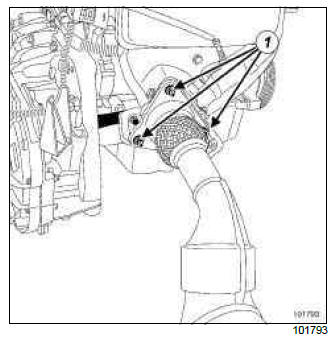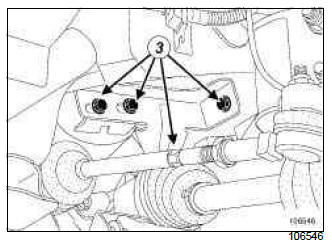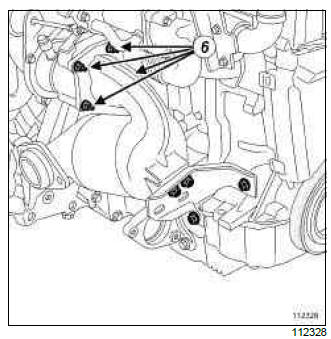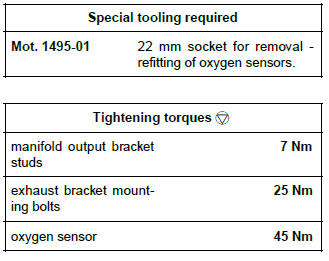Renault Clio: Catalytic converter: Removal - Refitting
K4J or K4M

IMPORTANT
Catalytic converters contain ceramic fibres: these are contained within a closed unit, and cannot disperse.
Cutting or drilling catalytic converters is prohibited.
REMOVAL
I - REMOVAL PREPARATION OPERATION
- Position the vehicle on a two-post lift (see Vehicle: Towing and lifting) (MR 392, 02, Lifting equipment).
- Remove the connector from the downstream oxygen sensor.
- Unclip the wiring harness from the downstream oxygen sensor.
- Cut the exhaust pipe (see ) and (see 19B, Exhaust, Exhaust: Precautions for the repair, 19B- 19).
II - OPERATION FOR REMOVAL OF PART CONCERNED

- Remove:
- the catalytic converter mounting nuts (1) from the exhaust manifold
- the exhaust catalytic converter,
- the downstream oxygen sensor of the catalytic converter using tool (Mot. 1495-01).
REFITTING
I - REFITTING PREPARATIONS OPERATION
- Refit the oxygen sensor.
- Torque tighten the oxygen sensor (45 Nm).
- Replace the exhaust flange seal.
II - REFITTING OPERATION FOR PART CONCERNED
- Torque tighten the manifold studs (7 Nm).
- Fit:
- the catalytic converter,
- the catalytic converter sleeve (see 19B, Exhaust, Exhaust: Precautions for the repair, 19B- 19).
- Torque tighten the nuts mounting the catalytic converter on the exhaust manifold (21 Nm).
III - FINAL OPERATION
- Torque tighten:
- the exhaust sleeve (25 Nm) while supporting the exhaust pipe to ensure correct alignment,
- the exhaust manifold studs (8 Nm),
- the exhaust sleeve (25 Nm) while supporting the exhaust pipe to ensure correct alignment.
- Connect the oxygen sensor connector.
- Make sure that all the exhaust pipe heat shields are in place and properly secured.
- Refit the engine undertray.
- Make sure that there is no contact with the underbody.
WARNING
Make sure:
- position the sleeve " bolt - tightening nut " assembly vertically with the nut facing downwards to prevent any risk of underbody contact,
- that you position the new component in a way that the cutting area marks are aligned,
- that the two marks are flush with the two ends of the sleeve,
- that an old sleeve is not reused.
K9K

IMPORTANT
Catalytic converters contain ceramic fibres; these are contained within a closed unit and cannot be dispersed. Drilling or cutting catalytic converters is prohibited.
REMOVAL
I - REMOVAL PREPARATION OPERATION
- Position the vehicle on a two-post lift (see Vehicle: Towing and lifting) (MR 392, 02, Lifting equipment).
- Disconnect the battery (see Battery: Removal - Refitting) (MR 392, 80A, Battery).
- Remove:
- the engine cover,
- the air inlet duct,
- the scuttle panel grille (see Scuttle panel grille: Removal - Refitting) (MR 393, 56A, Exterior equipment),
- the two shock absorber cup covers,
- the scoop under the scuttle panel grille (see Scoop under the scuttle panel grille: Removal - Refitting) (MR 393, 56A, Exterior equipment),
- the engine undertray.
- Remove:
- the engine tie-bar (see 19D, Engine mounting, Lower engine tie-bar: Removal - Refitting, 19D-13),
- the wiring harness mountings between the catalytic converter and the exhaust pipe,
- the rubber bush mountings of the exhaust pipe on the bodywork.
- Withdraw the exhaust pipe.

- Remove:
- the downstream strut mountings (1) on the gearbox,
- the catalytic converter downstream strut mounting bolt (2),
- the downstream strut.

- Remove:
- the upstream strut mountings (3),
- the upstream strut.
II - OPERATION FOR REMOVAL OF PART CONCERNED

- Remove:
- the lifting eye mounting bolts (4) on the timing end,
- the lifting eye on the timing end,
- the mounting bolt (5) from the air inlet tube,
- the air inlet duct.

- Remove:
- the bolts (6) mounting the catalytic converter to the turbocharger,
- the catalytic converter and its seal on the turbocharger,
- the sealing ring or the seal (depending on the version) then dispose of them in a waste bin.
REFITTING
I - REFITTING OPERATION FOR PART CONCERNED
- Clean the bearing faces of the turbocharger and catalytic converter using an abrasive pad .
- Degrease the bearing faces using surface cleaner and clean cloths .

- In case of replacement, torque tighten the turbocharger output studs (7 N.m).
- Fit the catalytic converter equipped with a new seal on the turbocharger.
- Pretighten in order:
- the upstream strut bolts on the engine,
- the downstream strut bolts on the gearbox,
- the upstream strut bolts on the catalytic converter,
- the downstream strut bolts on the catalytic converter,
- the catalytic converter/turbocharger mounting nuts.
- Tighten to torque and in order:
- the catalytic converter mounting nuts on the turbocharger (26 N.m),
- the bolts mounting the upstream strut on the engine (44 N.m),
- the bolts mounting the downstream strut on the gearbox (21 N.m),
- the bolts mounting the upstream strut on the catalytic converter (26 N.m),
- the bolt mounting the downstream strut on the catalytic converter (21 N.m).
- Refit:
- the air inlet duct,
- the lifting eye,
- the exhaust pipe,
- the rubber bush mountings of the exhaust pipe on the bodywork.
WARNING
Make sure there is no contact between the catalytic converter and the turbocharger oil return pipe.
WARNING
Always replace the sealing ring between the catalytic converter and the exhaust pipe with a new component.
- Refit a new sealing ring or a new seal (depending on the version).
- Torque tighten:
- in the event of replacement, the exhaust clamp studs on the catalytic converter output (7 N.m),
- the exhaust bracket nuts (21 N.m).
II - FINAL OPERATION
- Torque tighten the exhaust pipe rubber mounting bush mountings on the body (62 N.m).
- Make sure that there is no contact with the underbody.
- Refit the engine tie-bar (see 19D, Engine mounting, Lower engine tie-bar: Removal - Refitting, 19D-13).
WARNING
Check:
- the exhaust pipe is not touching the body,
- all the heat shields are present.
- Refit:
- the engine undertray,
- the scoop under the scuttle panel grille (see Scoop under the scuttle panel grille: Removal - Refitting) (MR 393, 56A, Exterior equipment),
- the two shock absorber cup covers,
- the scuttle panel grille (see Scuttle panel grille: Removal - Refitting) (MR 393, 56A, Exterior equipment),
- the air inlet duct,
- the engine cover.
- Connect the battery (see Battery: Removal - Refitting) (MR 392, 80A, Battery).
D4F, and 740 or 764

REMOVAL
I - REMOVAL PREPARATION OPERATION
- Position the vehicle on a two-post lift (see Vehicle: Towing and lifting) (MR 392, 02, Lifting equipment).

- Remove:
- the engine undertray mounting bolts,
- the engine undertray,
- the downstream oxygen sensor (1) using the (Mot.1495-01).
- Cut the exhaust pipe (see ) and (see 19B, Exhaust, Exhaust: Precautions for the repair, 19B- 19).
II - OPERATION FOR REMOVAL OF PART CONCERNED

- Remove:
- the exhaust clamp mounting bolts (2),
- the catalytic converter.
IMPORTANT
Catalytic converters contain ceramic fibres; these are contained within a closed unit and cannot be dispersed. Drilling or cutting catalytic converters is prohibited.
REFITTING
I - REFITTING PREPARATIONS OPERATION

WARNING
It is essential to replace the sealing ring between the exhaust manifold and the catalytic converter.
- Position the after sales sleeve on the catalytic converter (see 19B, Exhaust, Exhaust: Precautions for the repair, 19B-19).
II - REFITTING OPERATION FOR PART CONCERNED
- When replacing, torque tighten the manifold output bracket studs (7 Nm).
- Refit the catalytic converter.
- Torque tighten the exhaust bracket mounting bolts (25 Nm).
- Torque tighten the after-sales sleeve (see 19B, Exhaust, Exhaust: Precautions for the repair, 19B-19).
III - FINAL OPERATION.
- Torque tighten the oxygen sensor (45 Nm) using the (Mot. 1495-01).
- Refit:
- the engine undertray,
- the engine undertray mounting bolts,
- Check:
- that there is no contact with the underbody,
- all the exhaust pipe heat shields are in place and properly attached.
WARNING
Any damaged heat shields must be replaced.
M4R

REMOVAL
I - REMOVAL PREPARATION OPERATION
- Put the vehicle on a two-post lift (see Vehicle: Towing and lifting).
- Remove the engine cover.
- Disconnect the battery .
- Remove:
- the engine undertray,
- the upstream and downstream oxygen sensors (see 17B, Petrol injection, Oxygen sensors: Removal - Refitting, 17B-19).
- Cut the exhaust pipe in the area to be cut number 1 (see 19B, Exhaust, Exhaust: Precautions for the repair, 19B-19) and .
II - REMOVAL OF PART CONCERNED

- Remove:
- the exhaust clamp mounting bolts,
- the catalytic converter,
- the exhaust flange sealing ring.
IMPORTANT
Catalytic converters contain ceramic fibres; these are contained within a closed unit, and cannot disperse. Cutting or drilling catalytic converters is prohibited.
REFITTING
I - REFITTING PREPARATION OPERATION

- Always replace the exhaust flange sealing ring.
II - REFITTING THE PART CONCERNED
- Position the after sales sleeve on the catalytic converter (see 19B, Exhaust, Exhaust: Precautions for the repair, 19B-19).
- Torque tighten the exhaust flange mounting bolts (21 Nm).
III - FINAL OPERATION
- Refit:
- the upstream and downstream oxygen sensors (see 17B, Petrol injection, Oxygen sensors: Removal - Refitting, 17B-19),
- the engine undertray.
- Connect the battery .
- Refit the engine cover.
F4R
The emission control assembly is comprised of two catalytic converters on the vehicle:
- one integrated into the exhaust manifold,
- one integrated into the exhaust pipe.
The method below deals with the operating procedure on the catalytic converter integrated into the exhaust pipe.
Note: The catalytic converter integrated into the exhaust manifold cannot be separated from the latter. When removing - refitting the catalytic converter, the catalytic converter - exhaust manifold assembly must be removed (see 12A, Fuel mixture, Exhaust manifold: Removal - Refitting, 12A-74). When replacing the catalytic converter, the catalytic converter - exhaust manifold assembly must be replaced.
REMOVAL
I - REMOVAL PREPARATION OPERATION
- Position the vehicle on a two-post lift (see Vehicle: Towing and lifting) (MR 392, 02, Lifting equipment).
- Disconnect the battery (see Battery: Removal - Refitting) (MR 392, 80A, Battery).
II - OPERATION FOR REMOVAL OF PART CONCERNED
1 - Removing the catalytic converter integrated into the exhaust manifold
- Remove the exhaust manifold (see 12A, Fuel mixture, Exhaust manifold: Removal - Refitting, 12A-74).
2 - Removing the catalytic converter integrated into the exhaust pipe
- Remove the downstream oxygen sensor (see 17B, Petrol injection, Oxygen sensors: Removal - Refitting, 17B-19).
- Cut the exhaust system at the cutting area ZC1 for this purpose (see ) and (see 19B, Exhaust, Exhaust: Precautions for the repair, 19B-19).

- Remove:
- the exhaust pipe clamp (1),
- the catalytic converter integrated into the exhaust pipe.
REFITTING
I - REFITTING OPERATION FOR PART CONCERNED
1 - Refitting the catalytic converter integrated into the exhaust manifold
- Refit the exhaust manifold (see 12A, Fuel mixture, Exhaust manifold: Removal - Refitting, 12A-74).
2 - Refitting the catalytic converter integrated into the exhaust pipe
- Fit the catalytic converter integrated into the exhaust pipe.
- Tighten the new exhaust pipe clamp by several turns.
- Fit the new After-Sales sleeve following the instructions supplied (see 19B, Exhaust, Exhaust: Precautions for the repair, 19B-19).
- Remove the downstream oxygen sensor (see 17B, Petrol injection, Oxygen sensors: Removal - Refitting, 17B-19).
II - FINAL OPERATION
- Make sure there is no contact with the underbody.
- Connect the battery (see Battery: Removal - Refitting) (MR 392, 80A, Battery).
- Start the engine and check that there are no leaks: deal with any problems as necessary.
D4F, and 784 or 786

REMOVAL
I - REMOVAL PREPARATION OPERATION
- Position the vehicle on a two-post lift (see Vehicle: Towing and lifting) (MR 392, 02A, Lifting equipment).
- Disconnect the battery (see Battery: Removal - Refitting) (MR 392, 80A, Battery).
- Remove:
- the engine cover,
- the engine undertray.
- Drain the gearbox (see Manual gearbox oils: Draining - Filling) (MR 392, 21A, Manual gearbox).

- Remove the nuts from the exhaust bracket at the catalytic converter outlet.

- Remove:
- the front right-hand hand wheel driveshaft (see Front right-hand driveshaft: Removal - Refitting) (MR 392, 29A, Driveshafts),
- the front right-hand wheel driveshaft relay bearing nuts (2),
- the front right-hand wheel driveshaft relay bearing.

- Disconnect the upstream oxygen sensor connector (3).
- Unclip the upstream oxygen sensor connector.
- Detach the upstream oxygen sensor wiring harness at (4).
- Remove:
- the bolts (5) from the turbocharger heat shield,
- the turbocharger heat shield.

- Disconnect the downstream oxygen sensor connector (6).
- Unclip the downstream oxygen sensor connector.
- Detach the downstream oxygen sensor wiring harness at (7).

- Remove:
- the nut (8) from the turbocharger strut,
- the bolt (9) from the turbocharger strut,
- the turbocharger strut.

- Disconnect the oil pressure sensor connector.
- Undo the bolts (10) on the catalytic converter primary strut.
- Remove:
- the catalytic converter upstream strut bolts (11),
- the catalytic converter upstream stay,
- the bolts (12) on the cylinder block primary strut,
- the primary strut from the cylinder block.

- remove:
- the clips (13) from the upper heat shield,
- the upper heat shield.
II - OPERATION FOR REMOVAL OF PART CONCERNED

- Remove:
- the nuts (14) mounting the catalytic converter on the turbocharger and the spacers,
- the catalytic converter,
- the catalytic converter seal on the turbocharger.
IMPORTANT
Catalytic converters contain ceramic fibres; these are contained within a closed unit, and cannot disperse. Cutting or drilling catalytic converters is prohibited.
- When replacing the catalytic converter, remove the upstream and downstream oxygen sensors on the workbench using the (Mot. 1495-01).
REFITTING
I - REFITTING PREPARATIONS OPERATION
- When replacing the catalytic converter, refit the upstream and downstream oxygen sensors on the workbench.
- Torque tighten the upstream and downstream oxygen sensors (45 Nm) using the (Mot. 1495-01).
- Always replace:
- the catalytic converter seal,
- the catalytic converter nuts on the turbocharger,
- Use abrasive pads to clean the bearing faces of:
- the turbocharger,
- the catalytic converter.
- Degrease the pressure faces using SURFACE
CLEANER (see Vehicle: Parts and consumables
for the repair) (MR 392, 04B, Consumables - Products)
and a clean cloth:
- the turbocharger,
- the catalytic converter.
II - REFITTING OPERATION FOR PART CONCERNED

- Refit:
- the catalytic converter seal on the turbocharger,
- the catalytic converter,
- the new nuts with the catalytic converter spacers on the turbocharger,
- the catalytic converter primary strut,
- the bolts (15) on the cylinder block primary strut,
- the primary strut bolt (16) on the gearbox,
- the catalytic converter upstream stay,
- the catalytic converter upstream strut bolts (18) and (19),
- the turbocharger strut.
- the bolt (21) from the turbocharger strut,
- the turbocharger strut nut (20).
- Torque tighten:
- the primary strut bolts on the cylinder block (25 Nm) by locking the strut on the gearbox lug at (15),
- the primary strut bolt on the gearbox (44 Nm) at (16),
- the catalytic converter nuts on the turbocharger (initial torque) (20 Nm),
- the catalytic converter nuts on the turbocharger (30 Nm),
- the primary strut bolts on the catalytic converter (initial torque) (20 Nm) at (17),
- the primary strut bolts on the catalytic converter (30 Nm),
- the catalytic converter upstream strut bolts on the catalytic converter (21 Nm) at (18),
- the catalytic converter upstream strut bolts on the cylinder block (21 Nm) at (19),
- the turbocharger strut nut (21 Nm) at (20),
- the turbocharger strut bolt (21 Nm) at (21).
III - FINAL OPERATION.
- Refit:
- the upper heat shield,
- the clips on the upper heat shield.
- Connect the oil pressure sensor connector.
- Attach the downstream oxygen sensor wiring harness.
- Fit the downstream oxygen sensor connector.
- Connect the downstream oxygen sensor connector.
- Refit:
- the turbocharger heat shield,
- the turbocharger heat shield bolts.
- Torque tighten the turbocharger heat shield bolts (8 Nm).
- Attach the upstream oxygen sensor wiring harness.
- Fit the upstream oxygen sensor connector.
- Connect the upstream oxygen sensor connector.
- Refit:
- the front right-hand wheel driveshaft relay bearing,
- the front right-hand wheel driveshaft relay bearing nuts.
- Torque tighten the front right-hand wheel driveshaft relay bearing nuts (44 Nm).
- Refit:
- the front right-hand hand wheel driveshaft (see Front right-hand driveshaft: Removal - Refitting) (MR 392, 29A, Driveshafts),
- exhaust bracket nuts.
- Torque tighten the exhaust bracket bolts at the catalytic converter outlet (9 Nm).
- Fill the gearbox oil (see Manual gearbox oils: Draining - Filling) (MR 392, 21A, Manual gearbox).
- Refit:
- the engine cover,
- the engine undertray.
- Connect the battery (see Battery: Removal - Refitting) (MR 392, 80A, Battery).

